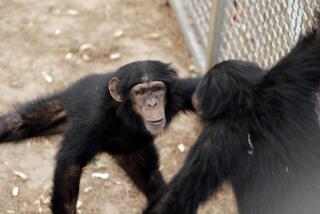Science/Medicine : Can We Really Talk to the Animals? : Not only can one species of animal communicate with one another, zoologists say, but some animals use language sounds to deceive one another by what appears to be deliberate manipulation of the meaning of symbols.
Sea gulls are social though not sociable, querulous to a fault, but they wouldn’t seem smart enough to prevaricate. Yet they have been caught doing just that by Eugene Morton, who is an ornithologist at the National Zoo in Washington, and this, along with a great deal of new research, is casting new light on the old question:
Do animals think?
Morton, who is as close as we have come to a scientific Dr. Dolittle, has found that all animals share a kind of grammar of expression that he calls “expressive sound symbols.” By these symbolic noises, animals can communicate their feelings of the moment, not just among themselves but across species lines.
Throughout the animal world, Morton found, angry animals growl; frightened, friendly or submissive animals whine, and an aroused or interested animal barks. While it is hard to imagine a bird barking, it can be seen to do so when its voice is recorded on a sonogram, a two-dimensional acoustic voiceprint often used to record and analyze bird songs.
The chirp of a bird and the bark of a dog, for example, both have the shape of a chevron. Growls--like those of a wren or a tiger--appear as thick bands.
This universal language (at least among animals with vocal capacities) evidently saves everyone a lot of time and energy. A territorial male can growl and perhaps discourage some intruder without having to fight.
Moreover, big animals tend to have lower voices than smaller ones. So a small animal making a low sound seems bigger; a high tonal whine sounds like a smaller animal or a young animal and becomes a sign of appeasement.
There can be shades of meaning as well. A screech could be a combination of an aggressive growl and the high-pitched whine of fear. And it gets more complicated than that.
For example, a mother goose being attacked by a fox may well have ambivalent feelings, Morton points out. She may be scared and impelled to flee. At the same time she is urgently impelled to protect her young. If she emits a vocal sound, it might go either way--high (submission) or low (aggression) or both--but the risk of honest fear erupting forth and the fox reading this accurately is too great.
Instead, geese in such situations emit a non-vocal sound. They hiss, which expresses neither emotion. The goose doesn’t lie by pretending to be fearless, but she doesn’t tell the truth either.
As for the gulls, biologists have noticed that in a flock the first one to spot a morsel of food will often but not always emit a high-pitched cry before diving for the food. It is clear that the gull is not being submissive and letting the other bullies get theirs first. Morton theorizes that the gull emits the high-pitched call to tell the others that it is under attack from some predator.
This has the effect of distracting the others, making them hesitate for a split second and giving the lying bird the chance to get there first.
The idea of animals deceiving one another by what appears to be deliberate manipulation of the meaning of symbols suggests that something at least akin to thought is going on. Certainly it suggests that the gull’s brain is capable of more than mere mechanical reactions to outside stimuli--possibly a kind of conscious awareness. Of course, since the ploy evidently continues to work time after time, it suggests a little bit less than what would be called intelligence.
Philosophers and animal behaviorists have typically sought to explain the activities and even apparent group strategies of animals as genetically programmed or the result of fairly mechanical conditioned response (a form of learning), which most of them surely are.
Thinking, awareness and consciousness have largely been denied non-human creatures for many reasons ranging from fear of anthropomorphism to the fact that it is simply difficult to ask an animal what it is thinking or if it is thinking at all.
Recently, however, impelled by a book called “Animal Thought” by Donald Griffin of Rockefeller University, a number of zoologists have opened up the question of thoughtful behavior in the rest of the animal kingdom.
Deliberate deceit has been found nowhere in the animal kingdom so much as among primates. In one flagrant case, a female hamadryad baboon engaged in a clandestine affair with a younger male. Typically in such troops, a dominant male sees to it that the harem remains faithful to him.
In this instance, the illicit pair hid from the old boy behind a rock. After each coupling, the female would look up innocently over the rock and, in one instance, went over to the leader and presented herself as available to him, reassuring him that all was well before heading back for more trysting behind the rock.
Intentionality is what scientists in this realm call a “mental state,” clearly a prerequisite for thinking. David Premack and his colleagues at the University of California, Berkeley, set out some years ago to see if a chimpanzee was able to attribute a mental state to a human being.
It was a new wrinkle on earlier studies that had shown that a chimpanzee was smart enough to figure out that by piling two boxes up to make a platform, it could reach some bananas hung otherwise out of reach.
In this instance, Premack showed a chimpanzee a videotape of a human jumping up and down, waving his arms, trying to reach a bunch of bananas overhead. Then the chimp was shown several photographs.
Most of them were utterly irrelevant, but one photo showed two boxes piled one on top of the other. The chimp had never been involved in the reaching-for-the-banana gambit, but it had been trained that the choice of a situationally relevant photograph would lead to a reward. The chimp chose the photograph of the boxes piled up.
It is difficult not to think that the chimp correctly attributed a mental state--intention--to the human since otherwise the photograph of two boxes piled up would have had no meaning whatsoever.
Deceit and cheating may have played a significant role in the origins and development of intellect. That is because deceit and cheating are the reverse of reciprocal altruism, which is practiced among many animals besides humans--most notably perhaps among our primate cousins.
In the Gombe Reserve, for example, scientists often spot a male baboon enlisting the aid of another male to help attack a third male, usually when the third one is involved with an estrous female.
Typically in such situations, the first baboon runs off with the female while the enlistee and the cuckold finish the fight. In the words of Colin Beer of Rutgers, the “solicited male gets the blows while his friend gets the girl.” Importantly, observers have found that more often than not the solicited male later asks for the same favor, and it is granted. Long-term partnerships form from such cooperation.
For such a situation to arise--and to work well enough to continue--several factors must be present. First, the society in question has to be small enough so that all the members can recognize one another. (You wouldn’t expect a pair of sea gull con artists to team up.)
Second, the group has to be stable enough over time to provide opportunities for the repetitive getting and giving of assistance. And the members of the group have to be smart enough to keep score.
Even so, given the notion that it is to a male’s advantage to sow his genes as far and wide as possible, there could be a payoff for a cheater. A blatant cheater who accepted help but never proffered it in return would probably not get away with it for very long before being ostracized, but this still leaves considerable inducement for ever more clever attempts to cheat (like the hamadryad female consorting behind the rock). And this in turn would force the altruists in the society to become ever more clever in spotting deceitful behavior.
Some scientists have suggested that it was precisely this kind of “arms race” between two strategies--cheating and altruism--that ultimately escalated into the highest form of intelligence we know: ours.
But certainly, the kind of altruism observed in the Gombe baboons cannot be understood as anything but intentional. One animal must persuade another that it wants help and that it will return the favor. That sounds like thinking.
Even so, this area of science is a perilous thicket, replete with problems of definition as well as experimental design and interpretation. But today a growing number of scientists are beginning to peer through that opaque lens that separates us, so completely it seems, from the rest of animal life and, perhaps, mind.
As different as we are from other animals, we share an enormous array of physiological, biochemical and behavioral similarities.
As Carolyn Ristau of New York’s Rockefeller University has said: “We and most existent animal life have nervous systems that are remarkably similar, and most neurons are connected by synapses that also seem quite similar.
“If we wish to assume other species are not conscious, what is it that is so distinctly different about our nervous system that precludes consciousness in other species?”






